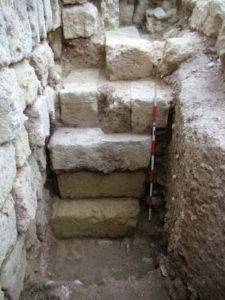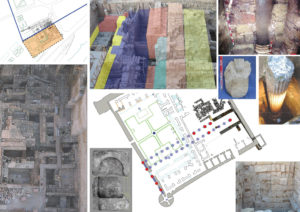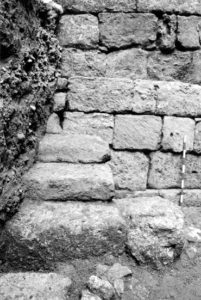
Walls

The multiplicity of functions of the walled enclosures in Late Antiquity (defensive and deterrent role, element of prestige and power, etc.) favored a continuous maintenance by the authorities.

In the case of Cordova, the archaeological documentation reflects the maintenance of the roman walled perimeter and its continuous reinforcement. At first (third to fifth centuries) we have knowledge of the feasible collapse and subsequent repair of a pair of sections corresponding to the eastern wall of the wall; of the possible closure of the primitive Porta Praetoria (and its transfer to the ancient Osario’s Gate) and a series of important renovations that affected the southwestern corner of the Cordoban city walls.

The probable location of the portus cordubensis in the southwestern corner of the city, and the periodical rise of the Baetis river, led to a continuous reinforcement of the wall, whose thickness went from 2,20 m (beginnings of third century) to more than 8,25 (early fifth century). Such strengthening work culminated in the fifth century, when a rectangular fortified space of 95 x 45 m (length x width) was built. A fortified space (catellum), advanced towards the river and attached to the external face of the wall perimeter, it was part of the civil complex of the city.

If we advance to the sixth and seventh centuries, the continuous attacks and sieges suffered by Cordova in 550, 568, 572 and 584 seem to have been reflected in the wall enclosure, when the closure of the eastern gate of the Gate Bridge was detected, as the restoration of two sections of the eastern wall.
Bibliography
CARRASCO, I. et alii (2003): “Informe-Memoria de la Intervención Arqueológica de Urgencia en el Paseo de la Ribera (1999-2001). I. Sector de la Puerta del Puente”, Anuario Arqueológico de Andalucía 2000, vol. III, Sevilla, 283-298.
COURAULT, C. (2016): Les remparts de Cordoue. Une investigation archéologique depuis l’Antiquité jusq’à l’époque Médiévale. Tesis doctoral (inédita), Córdoba.
HIDALGO, R. (2005): “Algunas cuestiones sobre la Corduba de la antigüedad tardía”, en J.Mª. GURT y A.V. RIBERA (coords.), VI Reunió d´Arqueologia Cristiana Hispànica, Barcelona, 401-414.
LEÓN, A.; MURILLO, J. F. (2009): “El complejo civil tardoantiguo de Córdoba y su continuidad en el Alcázar Omeya”, Madrider Mitteilungen, nº 49, 323-335.
LÓPEZ, N. (2002): “Nuevos datos sobre la muralla este de Córdoba”, Arte, Arqueología e Historia, nº 9, 103-109.
MORENA, J. A. (1996): Las murallas de Córdoba. Documentación (inédita) de expediente incoado como Zona Arqueológica para su inscripción en el Catálogo General del Patrimonio Histórico Andaluz en la provincia de Córdoba, Córdoba.
MURILLO, J.F. et alii (2010): “La transición de la civitas clásica cristianizada a la madina islámica a través de las transformaciones operadas en las áreas suburbiales”, en D. VAQUERIZO y J.F. MURILLO (eds.), El anfiteatro romano de Córdoba y su entorno urbano. Análisis arqueológico (ss. I-XIII d.C.). Monografías de Arqueología Cordobesa, nº 19, vol. II, Córdoba, 503-547.
ORTIZ, F. R. (2011): “A.A.P. Ronda de Isasa 2 y c/ Amparo 1 (Córdoba)”, Anuario Arqueológico de Andalucía 2005, Sevilla, 489-499.
RUIZ NIETO, E. (2003): “Intervención Arqueológica de Urgencia en el Paseo de la Victoria, 17”, Anuario Arqueológico de Andalucía 2000, vol. III, Sevilla, 475-482.
RUIZ BUENO, M.D.; VAQUERIZO, D. (2016): “Las murallas como paradigma urbano. Investigación y diacronía en Corduba (ss. II-VII d.C.)”, Cuadernos de Arqueología de la Universidad de Navarra, nº 24, 163-192.

